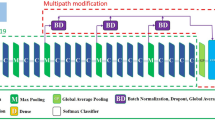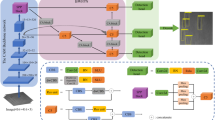Abstract
In order to address the problem of low efficiency and accuracy of artificial visual inspection for the quality of toy sets, this paper investigates the defect detection of toy sets based on machine vision. Firstly, an improved U-Net (IU-Net) is developed by introducing the Squeeze-and-Excitation (SE) block into the U-Net and modifying its objective function. Then, a convolutional neural network (CNN) is constructed for feature extraction and defect matching. Finally, a defect detection model for toy sets is created by integrating these two models. In addition, when it comes to a new-variety toy set, the IU-Net model is trained through transfer learning with a small number of new-variety data samples. This can reduce the dependence on new-variety data samples and improve the efficiency of model training process. The experimental results show that the defect detection accuracy of the proposed method is 100% and 99.43% for the whole toy set and single component, respectively, which meets the requirements of industrial automation quality inspection of toy sets.












Similar content being viewed by others
Data availability
The datasets used or analyzed during the current study are available from the corresponding author on reasonable request.
References
Smith, M.L., Smith, L.N., Hansen, M.F.: The quiet revolution in machine vision-a state-of-the-art survey paper, including historical review, perspectives, and future directions. Comput. Ind. 130, 103472 (2021)
Liu, G.H., Zheng, X.T.: Fabric defect detection based on information entropy and frequency domain saliency. Vis. Comput. 37(3), 515–528 (2021). https://doi.org/10.1007/s00371-020-01820-w
Ren, Z., Fang, F., Yan, N., Wu, Y.: State of the art in defect detection based on machine vision. Int. J. Precis. Eng. Manuf.-Green Technol. 9, 1–31 (2021)
Liu, G.H., Li, F.: Fabric defect detection based on low-rank decomposition with structural constraints. Vis. Comput. 38(2), 639–653 (2022). https://doi.org/10.1007/s00371-020-02040-y
Shaik, K.B., Ganesan, P., Kalist, V., Sathish, B.S., Jenitha, J.M.M.: Comparative study of skin color detection and segmentation in HSV and YCbCr Color space. Procedia Comput. Sci. 57, 41–48 (2015). https://doi.org/10.1016/j.procs.2015.07.362
Otsu, N.: A threshold selection method from gray-level histograms. IEEE Trans. Syst. Man Cybern. 9(1), 62–66 (1979)
Tsai, D.-M., Lin, C.-T.: Fast normalized cross correlation for defect detection. Pattern Recogn. Lett. 24(15), 2625–2631 (2003)
Heo, Y.S., Lee, K.M., Lee, S.U.: Robust stereo matching using adaptive normalized cross-correlation. IEEE Trans. Pattern Anal. Mach. Intell. 33(4), 807–822 (2010)
Kamoona, A.M., Gostar, A.K., Bab-Hadiashar, A., Hoseinnezhad, R.: Point pattern feature-based anomaly detection for manufacturing defects, in the random finite set framework. IEEE Access. 9, 158672–158681 (2021). https://doi.org/10.1109/access.2021.3130261
Suvdaa, B., Ahn, J., Ko, J.: Steel surface defects detection and classification using SIFT and voting strategy. Int. J. Softw. Eng. and Appl. 6(2), 161–166 (2012)
Nigam, A., Tripathi, R.C.: Trademark image retrieval using weighted combination of sift and HSV correlogram. Int. J. Comput. Appl. Technol. 54(1), 61–67 (2016)
Huang, Y.B., Qiu, C.Y., Yuan, K.: Surface defect saliency of magnetic tile. Vis. Comput. 36(1), 85–96 (2020). https://doi.org/10.1007/s00371-018-1588-5
Zheng, X.Q., Zheng, S., Kong, Y.G., Chen, J.: Recent advances in surface defect inspection of industrial products using deep learning techniques. Int. J. Adv. Manuf. Technol. 113(1–2), 35–58 (2021). https://doi.org/10.1007/s00170-021-06592-8
Wang, D., Hu, G.Q., Lyu, C.Z.: FRNet: an end-to-end feature refinement neural network for medical image segmentation. Vis. Comput. 37(5), 1101–1112 (2021). https://doi.org/10.1007/s00371-020-01855-z
Ma, A.L., Wan, Y.T., Zhong, Y.F., Wang, J.J., Zhang, L.P.: SceneNet: Remote sensing scene classification deep learning network using multi-objective neural evolution architecture search. ISPRS-J. Photogramm. Remote Sens. 172, 171–188 (2021). https://doi.org/10.1016/j.isprsjprs.2020.11.025
Chen, W.T., Ouyang, S.B., Yang, J.W., Li, X.J., Zhou, G.D.A., Wang, L.Z.: JAGAN: a framework for complex land cover classification using Gaofen-5 AHSI images. IEEE J. Sel. Top. Appl. Earth Observ. Remote Sens. 15, 1591–1603 (2022). https://doi.org/10.1109/jstars.2022.3144339
Hu, W.H., Wang, T., Wang, Y.S., Chen, Z.Y., Huang, G.H.: LE-MSFE-DDNet: a defect detection network based on low-light enhancement and multi-scale feature extraction. Vis. Comput. 38(11), 3731–3745 (2022). https://doi.org/10.1007/s00371-021-02210-6
Dai, W.T., Erdt, M., Sourin, A.: Detection and segmentation of image anomalies based on unsupervised defect reparation. Vis. Comput. 37(12), 3093–3102 (2021). https://doi.org/10.1007/s00371-021-02257-5
Dai, W.T., Erdt, M., Sourin, A.: Self-supervised pairing image clustering for automated quality control. Vis. Comput. 38(4), 1181–1194 (2022). https://doi.org/10.1007/s00371-021-02137-y
Zhou, G.D.A., Chen, W.T., Gui, Q.S., Li, X.J., Wang, L.Z.: Split depth-wise separable graph-convolution network for road extraction in complex environments from high-resolution remote-sensing images. IEEE Trans. Geosci. Remote Sens. 60, 15 (2022). https://doi.org/10.1109/tgrs.2021.3128033
Wang, Q., Meng, X.Y., Sun, T., Zhang, X.D.: A light iris segmentation network. Vis. Comput. 38(7), 2591–2601 (2022). https://doi.org/10.1007/s00371-021-02134-1
Wang, X.D., Xu, X.W., Wang, Y.L., Wu, P.T., Yan, F., Zeng, Z.Q.: A robust defect detection method for syringe scale without positive samples. Vis. Comput (2022). https://doi.org/10.1007/s00371-022-02671-3
Chen, X., Chen, J., Han, X., Zhao, C., Zhang, D., Zhu, K., et al.: A light-weighted CNN model for wafer structural defect detection. IEEE Access. 8, 24006–24018 (2020). https://doi.org/10.1109/access.2020.2970461
Lin, D., Li, Y., Prasad, S., Nwe, T.L., Dong, S., Oo, Z.M.: CAM-guided multi-path decoding U-net with triplet feature regularization for defect detection and segmentation. Know.-Based Syst. 228, 107272 (2021). https://doi.org/10.1016/j.knosys.2021.107272
Yang, L., Wang, Z., Gao, S.: Pipeline magnetic flux leakage image detection algorithm based on multiscale SSD network. IEEE Trans. Industr. Inf. 16(1), 501–509 (2020). https://doi.org/10.1109/TII.2019.2926283
Ronneberger, O., Fischer, P., Brox, T.: U-net: Convolutional networks for biomedical image segmentation. In: International Conference on Medical image computing and computer-assisted intervention, pp. 234–241 (2015)
Liu, R.Q., Li, M.H., Shi, J.C., Liang, Y.B.: (2021) fabric defect detection method based on improved U-net. J. Phys.: Conf. Ser. 1, 012160 (1948)
Li, X., Chen, H., Qi, X., Dou, Q., Fu, C.-W., Heng, P.-A.: H-DenseUNet: hybrid densely connected UNet for liver and tumor segmentation from CT volumes. IEEE Trans. Med. Imaging 37(12), 2663–2674 (2018). https://doi.org/10.1109/tmi.2018.2845918
Li, W., Qin, S., Li, F., Wang, L.: MAD-UNet: a deep U-shaped network combined with an attention mechanism for pancreas segmentation in CT images. Med. Phys. 48(1), 329–341 (2021)
Huang, H., Lin, L., Tong, R., Hu, H., Zhang, Q., Iwamoto, Y., et al.: Unet 3+: a full-scale connected unet for medical image segmentation. In: ICASSP 2020–2020 IEEE International Conference on Acoustics, Speech and Signal Processing (ICASSP), pp. 1055–1059 (2020)
Qin, X., Zhang, Z., Huang, C., Dehghan, M., Zaiane, O.R., Jagersand, M.: U2-Net: going deeper with nested U-structure for salient object detection. Pattern Recognit. 106, 107404 (2020). https://doi.org/10.1016/j.patcog.2020.107404
Milletari, F., Navab, N., Ahmadi, S.-A.: V-net: Fully convolutional neural networks for volumetric medical image segmentation. In: 2016 fourth international conference on 3D vision (3DV), pp. 565–571 (2016)
Chen, Z.Y., Huang, G.H., Wang, Y., Qiu, J.H., Yang, F., Yu, Z.W., et al.: Bi-deformation-UNet: recombination of differential channels for printed surface defect detection. Vis. Comput (2022). https://doi.org/10.1007/s00371-077-07554-7
Wang, X.J., Hua, Z., Li, J.J.: Cross-UNet: dual-branch infrared and visible image fusion framework based on cross-convolution and attention mechanism. Vis. Comput (2022). https://doi.org/10.1007/s00371-022-02628-6
Cheng, Z.M., Qu, A.P., He, X.F.: Contour-aware semantic segmentation network with spatial attention mechanism for medical image. Vis. Comput. 38(3), 749–762 (2022). https://doi.org/10.1007/s00371-021-02075-9
Kiran, I., Raza, B., Ijaz, A., Khan, M.A.: DenseRes-Unet: segmentation of overlapped/clustered nuclei from multi organ histopathology images. Comput. Biol. Med. 143, 105267 (2022)
Zhang, Z., Wu, C., Coleman, S., Kerr, D.: DENSE-INception U-net for medical image segmentation. Comput. Methods Programs Biomed. 192, 105395 (2020)
Wang, Z., Zou, Y., Liu, P.X.: Hybrid dilation and attention residual U-Net for medical image segmentation. Comput. Biol. Med. 134, 104449 (2021)
Hu, J., Shen, L., Sun, G.: Squeeze-and-excitation networks. In: Proceedings of the IEEE conference on computer vision and pattern recognition, pp. 7132–7141 (2018)
Kamal, U., Tonmoy, T.I., Das, S., Hasan, M.K.: Automatic traffic sign detection and recognition using SegU-net and a modified Tversky loss function with L1-constraint. IEEE Trans. Intell. Transp. Syst. 99, 1–13 (2019)
Milletari, F., Navab, N., Ahmadi, S.: V-Net: fully convolutional neural networks for volumetric medical image segmentation. In: 2016 Fourth International Conference on 3D Vision (3DV), pp. 565–571 (2016). doi:https://doi.org/10.1109/3DV.2016.79
Shin, H.C., Roth, H.R., Gao, M., Lu, L., Xu, Z., Nogues, I., et al.: Deep convolutional neural networks for computer-aided detection: cnn architectures, dataset characteristics and transfer learning. IEEE Trans. Med. Imaging 35(5), 1285–1298 (2016). https://doi.org/10.1109/TMI.2016.2528162
Baktashmotlagh, M., Harandi, M.T., Lovell, B.C., Salzmann, M.: Unsupervised domain adaptation by domain invariant projection. In: Proceedings of the 2013 IEEE International Conference on Computer Vision, pp. 769–776 (2013). doi:https://doi.org/10.1109/iccv.2013.100.
Yosinski, J., Clune, J., Bengio, Y., Lipson, H.: How transferable are features in deep neural networks? arXiv e-prints. arXiv:1411.1792 (2014)
Oquab, M., Bottou, L., Laptev, I., Sivic, J.: Learning and transferring mid-level image representations using convolutional neural networks. In: Proceedings of the IEEE conference on computer vision and pattern recognition, pp. 1717–1724 (2014)
Tanner, M.A., Wong, W.H.: The calculation of posterior distributions by data augmentation. J. Am. Stat. Assoc. 82(398), 528–540 (1987)
Dahl, G.E., Sainath, T.N., Hinton, G.E.: Improving deep neural networks for LVCSR using rectified linear units and dropout. In: 2013 IEEE international conference on acoustics, speech and signal processing, pp. 8609–8613 (2013)
Funding
This work is supported by the China-Japan Science and Technology Joint Committee of the Ministry of Science and Technology of the People’s Republic of China (Grant No. 2017YFE0128400), the National Natural Science Foundation of China (Grant No. 51905162), the Foundation for Innovative Research Groups of the National Natural Science Foundation of China (Grant No. 51621004), the Project of Science and Technology of Changsha (Grant No. kq2001015), the Key Research and Development program of Hunan Province (2021GK2007), and the program of Leading Scientific and Technological Innovation in High-tech Industries (2021GK4028).
Author information
Authors and Affiliations
Contributions
All authors contributed in writing and revising the manuscripts.
Corresponding author
Ethics declarations
Conflict of interest
The authors declare that they have no known competing financial interests or personal relationships that could have appeared to influence the work reported in this paper.
Additional information
Publisher's Note
Springer Nature remains neutral with regard to jurisdictional claims in published maps and institutional affiliations.
Rights and permissions
Springer Nature or its licensor (e.g. a society or other partner) holds exclusive rights to this article under a publishing agreement with the author(s) or other rightsholder(s); author self-archiving of the accepted manuscript version of this article is solely governed by the terms of such publishing agreement and applicable law.
About this article
Cite this article
Yang, D., Chen, N., Tang, Q. et al. Research on defect detection of toy sets based on an improved U-Net. Vis Comput 40, 1095–1109 (2024). https://doi.org/10.1007/s00371-023-02834-w
Accepted:
Published:
Issue Date:
DOI: https://doi.org/10.1007/s00371-023-02834-w




